In February 2016, Buffer was gearing up for launching Reply (formerly named Respond), our new tool to provide great social media customer service.
We mapped out marketing plans, collaborated with engineers and product managers, and gave six volunteers full access to our @buffer Twitter account.
Wait… what was that last one?
The idea to invite community member volunteers into our social media was meant as a short-term initiative, but it turned into something better: A new kind of community that has reshaped our Twitter strategy.
So what happens when a customer service-obsessed startup turns the support over to its community? We’d love to share what we’ve learned (so far) through the Twitter Squad experiment!
Hatching the idea of ‘Community Helpers’
Our Chief Happiness Officer, Carolyn, crafted the original idea of the Twitter Squad. At the time, we called these folks “Community Helpers.”
The core concept isn’t entirely new — many support forums (like Apple and Evernote) rely on community members to help other community members with troubleshooting and engaging new users.
At Buffer, our customer service philosophy strives for a genuine interaction that leaves all parties a bit happier at the end of the day. This has been a part of Buffer’s DNA since the very beginning, when our co-founders Joel and Leo aimed to answer every email in a personalized fashion.
On Twitter, that means we strive to reply to every tweet with a personal touch. We receive an average of 450 tweets per day, and sometimes we have a slower response time than our customers deserve.
Gearing up for our Respond launch, we knew this number could drastically rise.
Thus, two days before the launch…

Although we weren’t sure if this was the birth of a new program or simply an experiment, we went for it!
We were hoping that the Community Helpers could help us with:
- Triaging support tweets to our Twitter Heroes
- Replying to blog post shares
- Sending love back to folks who spread #BufferLove
The Hypothesis: With community members giving us a hand, Heroes could spend more time on troubleshooting tweets and our response time would be lower, providing a better experience to our customers.
Tapping into the strength of our community
To get the word out about the program, we started small. Caro tweeted this out:
What do you think about this customer service / community idea? :) https://t.co/hCj2ZjG3Kr pic.twitter.com/hGCNVkrP99
— Carolyn Kopprasch (@CaroKopp) February 24, 2016
We had 30 great applicants! After looking through their Twitter feeds to get a feel for each individual and their potential match with our tone and values, we asked some folks to respond to a few tweet examples. Caro chatted individually with each of these applicants to communicate the process and expectations.
We ended up with 6 helpers that we were excited to have jump into our Twitter account! We sent them over a Reference Guide that explained a bit about our expectations (or lack-thereof!) and also what kinds of tweets we hoped they’d answer:
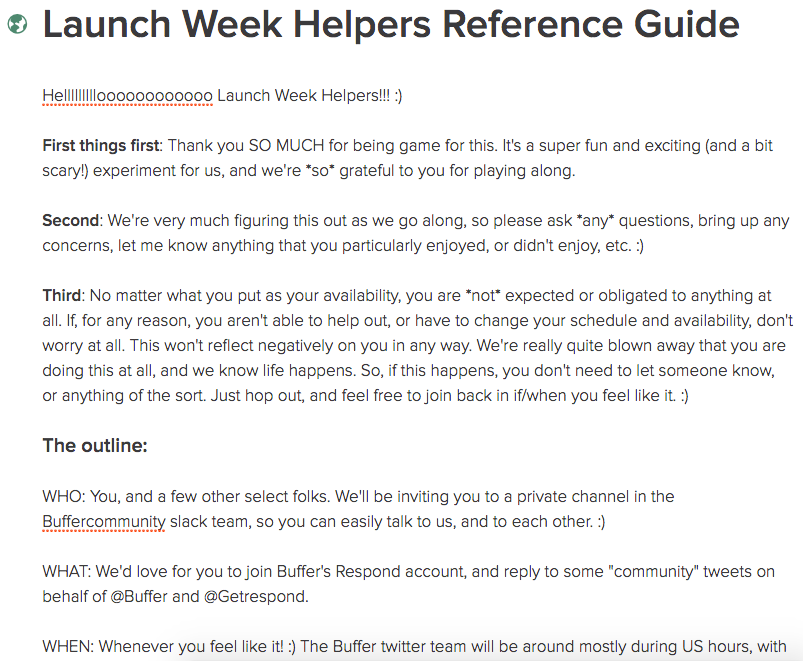
In case our friends had any questions throughout the week, we had a designated channel in our Buffer-Community Slack that was meant for chatter of any kind.
During the launch, our Community Helpers replied to 302 tweets, 9% of our total Twitter traffic that week.
Scaling the program
Fast forward to April, when we we had grown into a mighty (but small) Twitter Happiness Team of three.
We knew we had room to improve our response time. We also knew we had many engaged, active and loving Buffer community members who might be up for jamming out on tweets with us. We realized it could be incredible to pick up the helper program again.
We re-named the program to the Twitter Squad we know today and developed a new application looking for a few specific things:
-
- Does this person have a bit of our tone integrated into their application? (The more natural a tone fit they are, the more fun they’ll have on the squad.)
- Does this person’s Twitter profile reflect Buffer values?
- Is this person excited to chat with Buffer friends and followers?
Here is some of what our Twitter Squad application looks like:
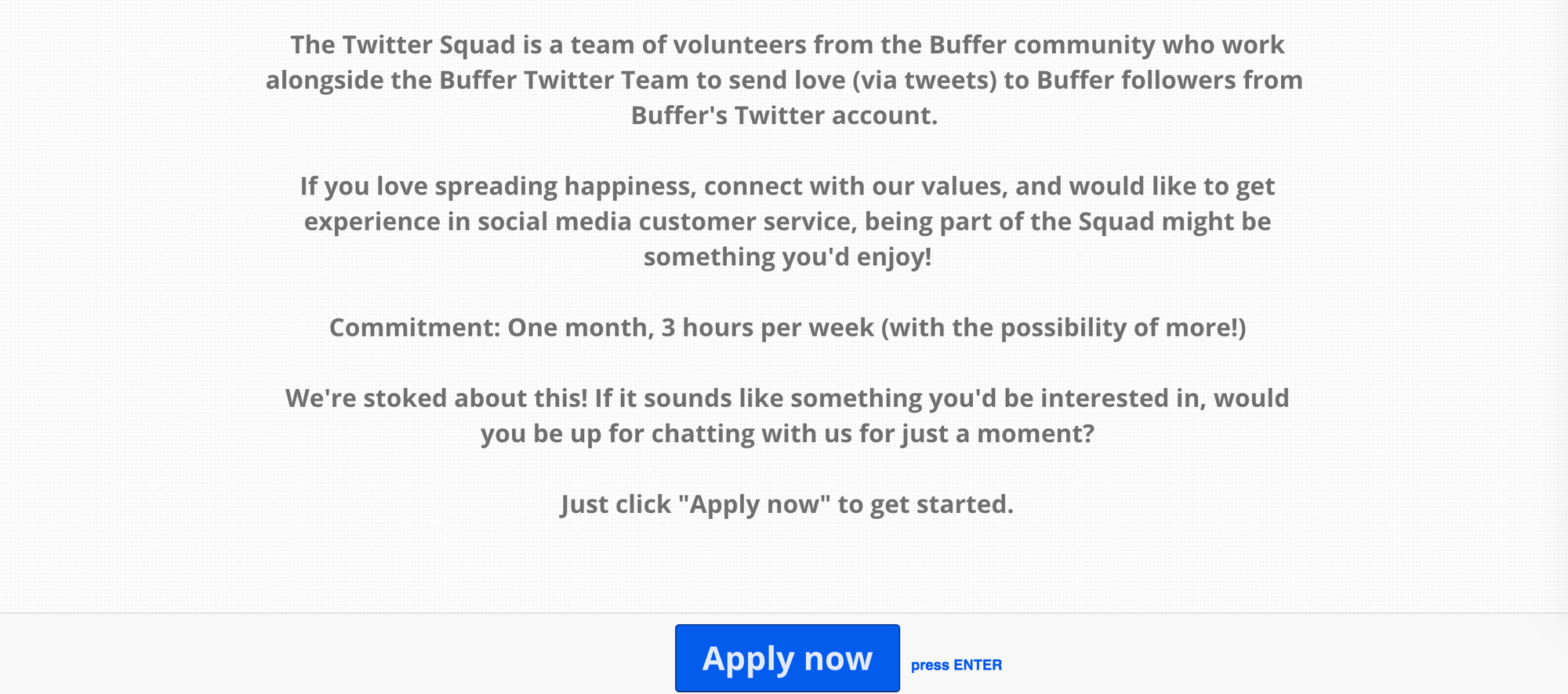
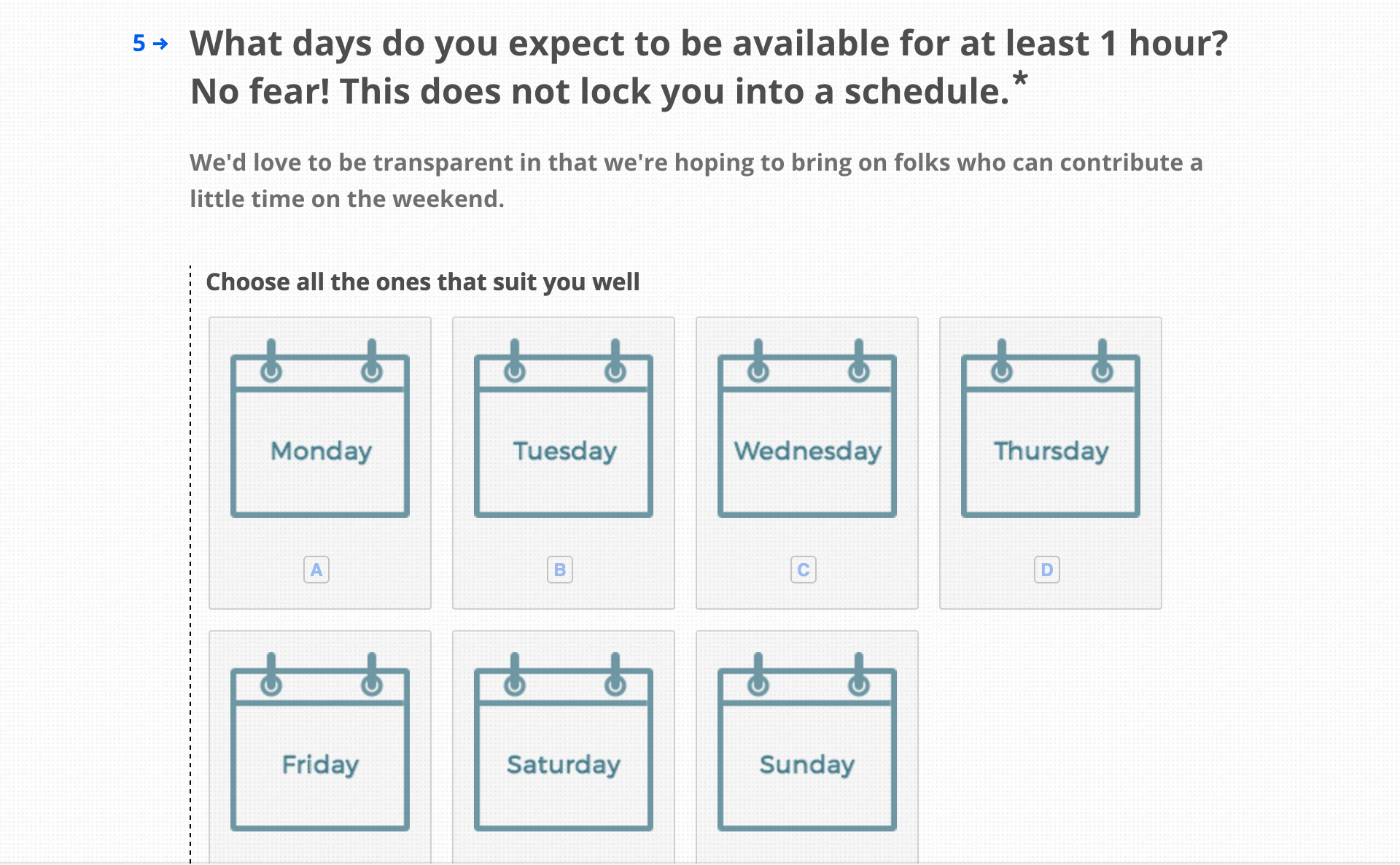
We also asked folks to try their hand at a few sample tweets, both positive and a bit more upset in tone:
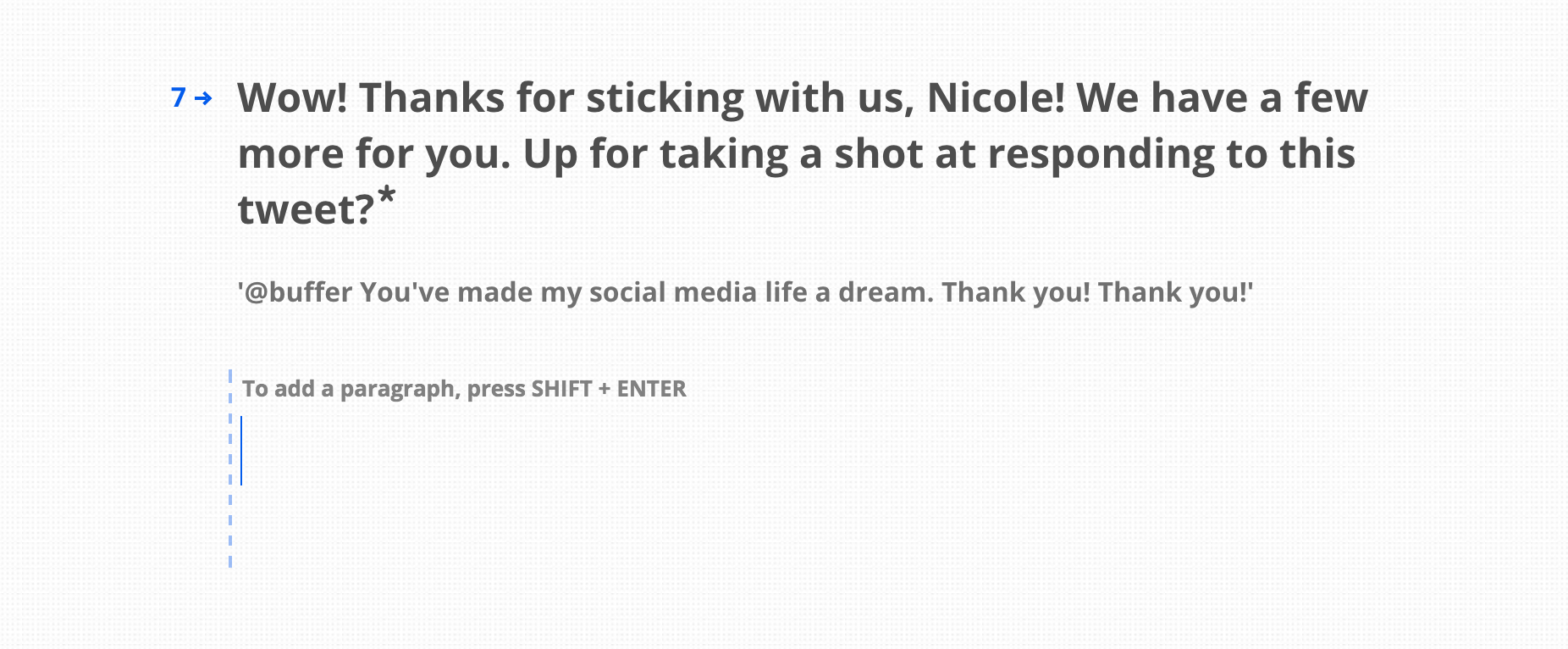
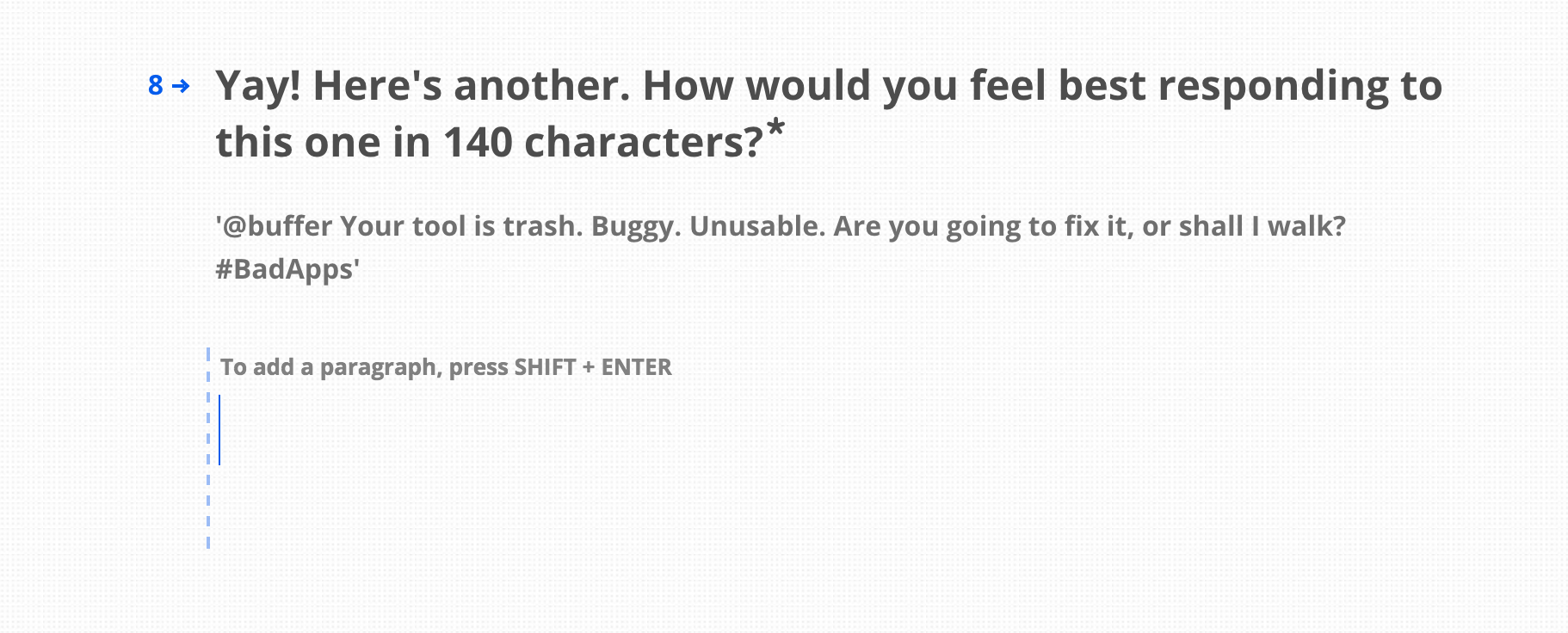
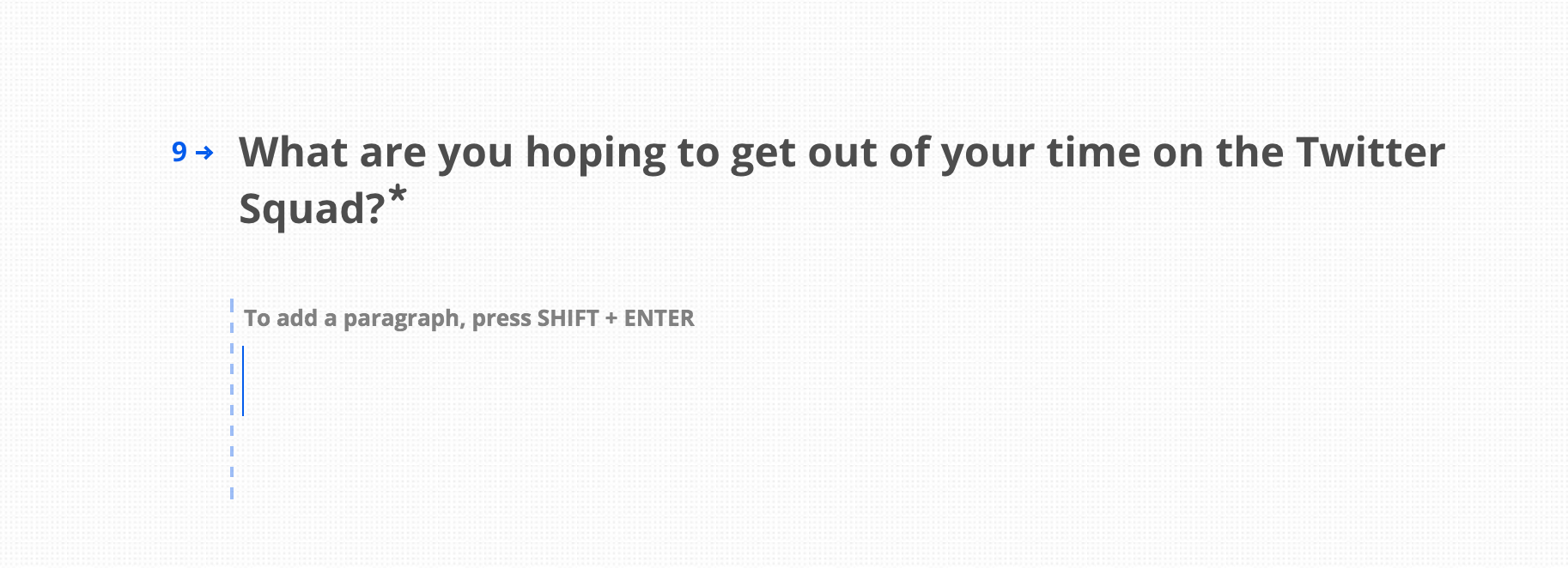
We asked our volunteers to commit at least one month, a minimum of three hours per week, to working with our Twitter crew, spreading love and happiness amongst our social media customers.
With four folks on board for our first official Twitter Squad, and sent them a few docs to get them started:
(Feel free to check the documents out yourself via the links below!)
Buffer Twitter Squad Reference Guide:
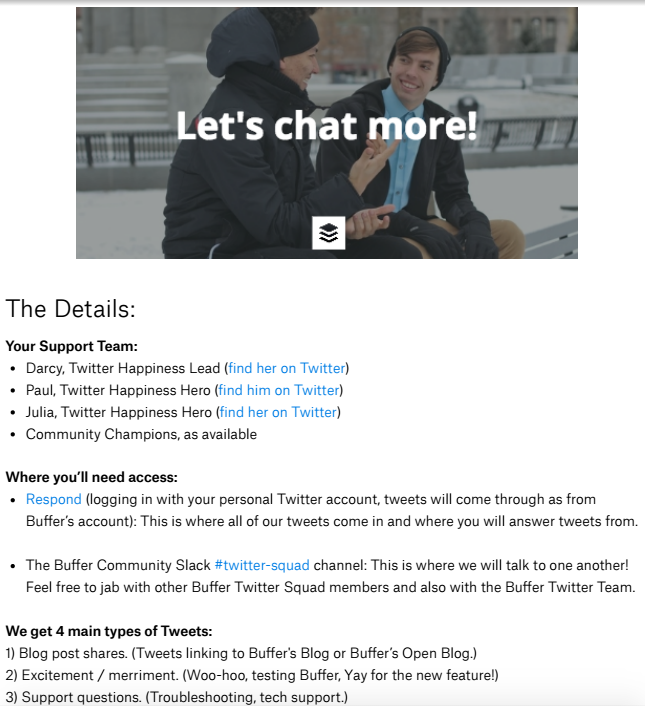
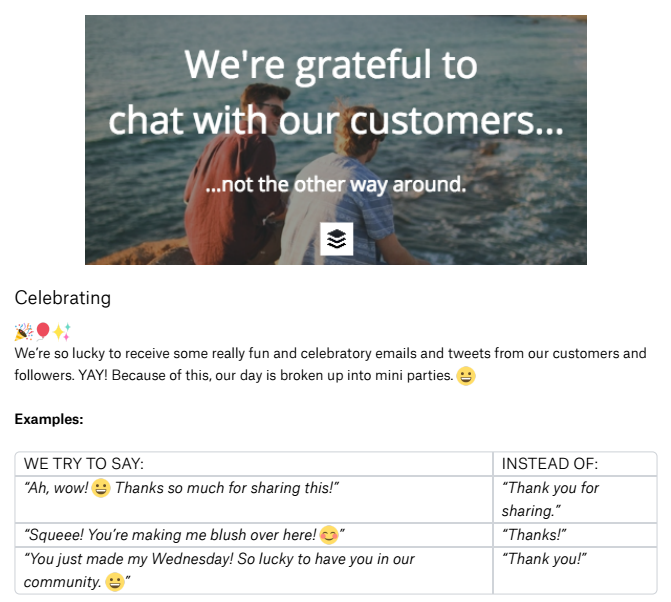
Buffer Twitter Squad Agreement:
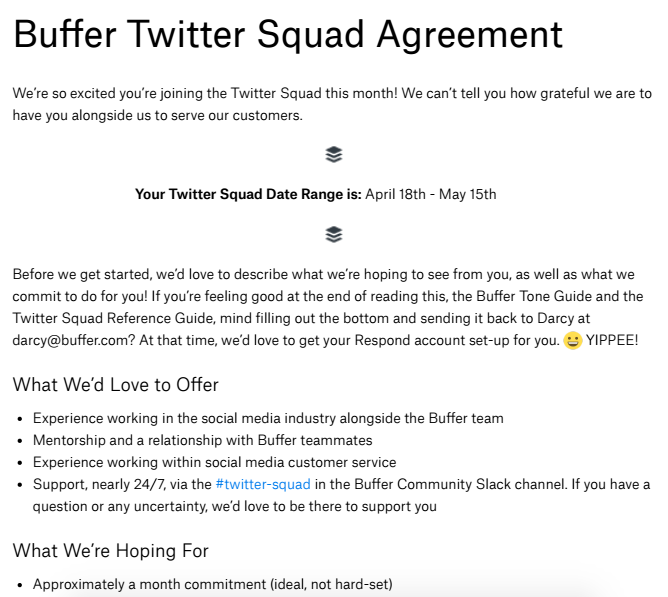
The Results: Thousands of tweets answered!
We weren’t nervous to see our community volunteers jump into our tweets—we were excited! Twitter Happiness Hero bootcampers start answering tweets within the first hour of their journey, so having our volunteers jump in right away felt natural for us.
To make sure the experience is great, we do put a few special measures in place when a new volunteer starts:
- We ask them to “assign” a Buffer team member the first 3–5 tweets they replied to so we can give real-time feedback and praise. (This is a handy feature of Respond!)
- We take a close peek at their tweets over the first week or so, with sporadic checks thereafter.
- We ensure the Squad member knows they can reach out via Slack at anytime to ask questions.
We couldn’t be more excited about the impact of the Squad team members! Since starting the Twitter Squad, we’ve decreased our average response time from 14.4 hours (in April) to 4.1 (in July).
Here are the numbers:
| Month | Squad Members | Tweets Sent |
| February | 6 | 324 |
| April | 4 | 227 |
| May | 9 | 1,284 |
| June | 8 | 1,012 |
| July | 21 | 3,258 |
We had such a great time with the Twitter Squad in April that we decided to ask them all to stay on board for as long as they’d like. This started a new Twitter Squad flow:
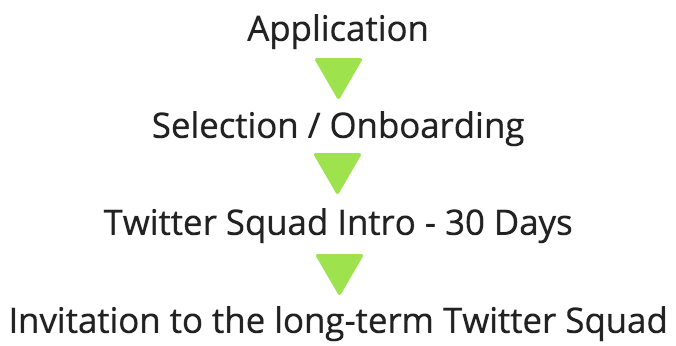
We were amazed that all four agreed to stay on! Wahoo! Also in May, we sent out a new application, bringing 5 more folks onboard.
Our new squad of 21 replied to 621 tweets during our four-day Buffer for Instagram launch—22% of our flow. Wow!
Behind the scenes with the squad
So what’s it like on the Buffer Twitter Squad? We asked a member to tell us!
ret Smith, a soccer coach for a high school girls varsity team in Pennsylvania, joined in May. He has been a fan of Buffer’s blog, tools and culture and and is thinking about making a career shift, potentially into customer service.
“I figured this would be a great way to try something new and interesting, while also helping out a company I greatly admire! I’ve been having a blast with it!” Bret says.
He has been spending 5–10 hours a week in Respond and has been enjoying sharing his personality with Buffer users around the globe.
Aw, thanks so much, Mike! Hope you're having an awesome Friday! -Bret pic.twitter.com/bNoQL20cYx
— Buffer (@buffer) August 5, 2016
“While I have been a Twitter user for quite a while, I’ve probably sent more tweets while on the Squad than I have in all the years I’ve been with Twitter combined!” Bret says. “I think I’ve really learned how to get the most out of the 140 character limit. Using emoji and GIFs can sometimes really help get your message across better than words can!”
Thanks a million for sharing this one, Sam! You're a rockstar! -Bret pic.twitter.com/Don85kRn4j
— Buffer (@buffer) July 23, 2016
Since Buffer language can be a bit unique, we asked our squad what word or phrase they now use that they didn’t use before. Here’s what some of them said:
Bret Smith: “Keen”
Christopher Church: “Woot woot!” or “Whoop!”
Erica Tafavoti: “Grateful” and “Resonated”
Halie Powell: “Stoked”
Ipsita Agarwal: “Thanks a bunch!”, “Thanks a million!”
Nicole Michelle: “You’re a ?!”
Sami Grady: “You bring a smile to my face!” and “Thanks for passing this forward!”
Tim Pateman: “’Tip-top”
Zala Bricelj: “Squeeee!” and “Aw, shucks.”
Arielle Rubenstein: “Curious to know…?”
Want to start your own squad? Scaling support through community
Would a community volunteer program fit your company or your team needs? Let’s explore a few questions to help make that call.
Do you need it?
Is your tweet flow a bit overwhelming? This could mean any number depending on your company and team structure — even 30 tweets a day can be quite a lot if you don’t have a dedicated support team or social media manager.
Can you devote the time you need?
There are aspects to the program that will take time—both one-time and ongoing projects. Here’s a sample of what our list looked like:
One-time or infrequently:
- Think about the structure of the program
- Create an application
- Advertise the application
- Read through applications
- Narrow down applicants
- Send out congratulations to your new members and regrets to your other applicants
- Create onboarding documents
- Chat back-and-forth about next steps for applicants
- Get them integrated into your systems
- Track first tweets and offer feedback
Ongoing:
- Chat with volunteers daily in the Slack channel
- Continually peek at tweets being sent out
- Send feedforward or praise to folks weekly
- Pull analytics weekly
- Make graphics for announcements, fun and celebration
- Get to know each one over DM
- Plan and execute monthly or twice monthly video chats
We’ve also found that having the right tools helps keep the team in sync and a bit more efficient.
A Twitter management tool like Respond is helpful to send internal notes on tweets, track stats and monitor community interactions. We also use Slack to share important announcements with our Twitter Squad.
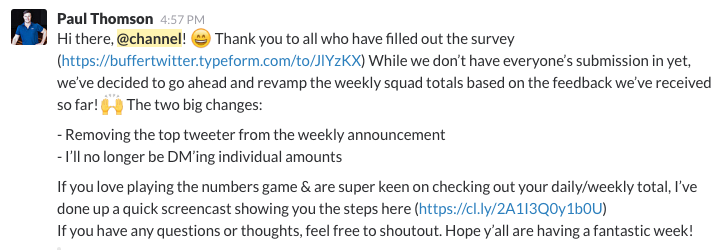
Quick tips to get your program started:
- Detail out what you’re hoping to achieve with a community engagement volunteer program.
- Determine who is the main point person for the community members and who will be responsible for each feature of the program.
- Craft an application that will help you understand how your applicants will fit within your organization.
- Clearly set expectations for your volunteers, while also letting them know what you’ll do for them.
- Discover ways to track progress and continually offer opportunities for volunteers to learn and grow (with feedback, encouragement.)
Don’t repeat our biggest mistake
No new program would be complete without a couple of blunders, and our biggest initial mistake was that we didn’t build enough of a community for our support volunteer
After several folks left the squad to give a bit more attention to other ventures, we started to realize that we hadn’t been doing quite enough to make our Twitter Squad members feel part of the family.
So we added a few new elements to the program to join ourSlack channel and motivational graphics:
- We celebrate the group’s efforts weekly:
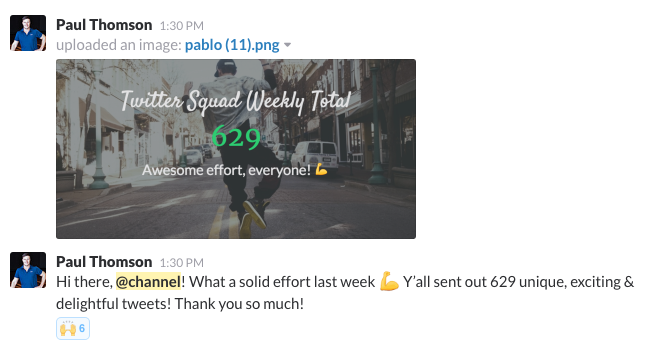
2. We celebrate individual efforts weekly:
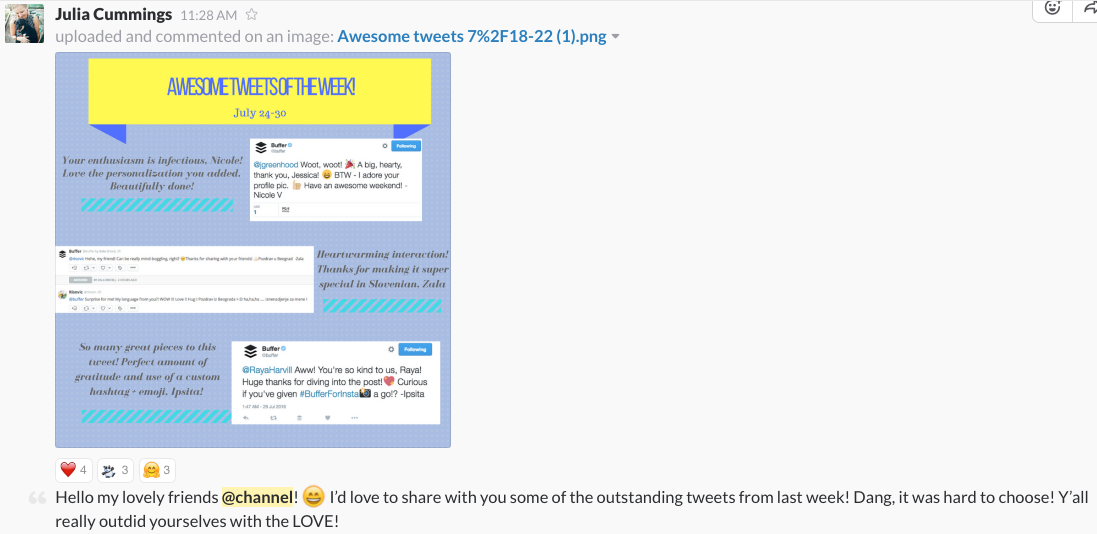
3. We aim to send both praise and feedforward via DM:

4. We started a Twitter Squad landing page to share a bit more about the program and to also highlight our current volunteers.
5. We planned a virtual group chat, and hope to continue to do these regularly. We’ll use these times to share quick announcements, to cover common questions (i.e. “There are so many blog post shares. How do I make my replies unique to each one?”), and to chat over an ice breaker question.
We’re going to continue to explore ways to deepen bonds and give back to our amazing volunteers.
After members leave, we’re now thinking about how to gain insights from their experience. What did they like/dislike, and how can we make it better for Squad members in the future? Also, if requested, we’d love to gift our former Squad members with a letter of reference for their new ventures.
Thanks, Twitter Squad!
Since starting the Twitter Squad, we’ve decreased our average response time from 14.4 hours (in April) to 4.1 (in July).
Noting that we also had a few internal structure changes, the Twitter Squad was a huge part in that!
We are able to more quickly respond to those who need our support, we are able to send love to almost every person who mentions Buffer and we now have an extended Buffer family. We couldn’t be more grateful to our former, current and future Buffer Twitter Squad members.
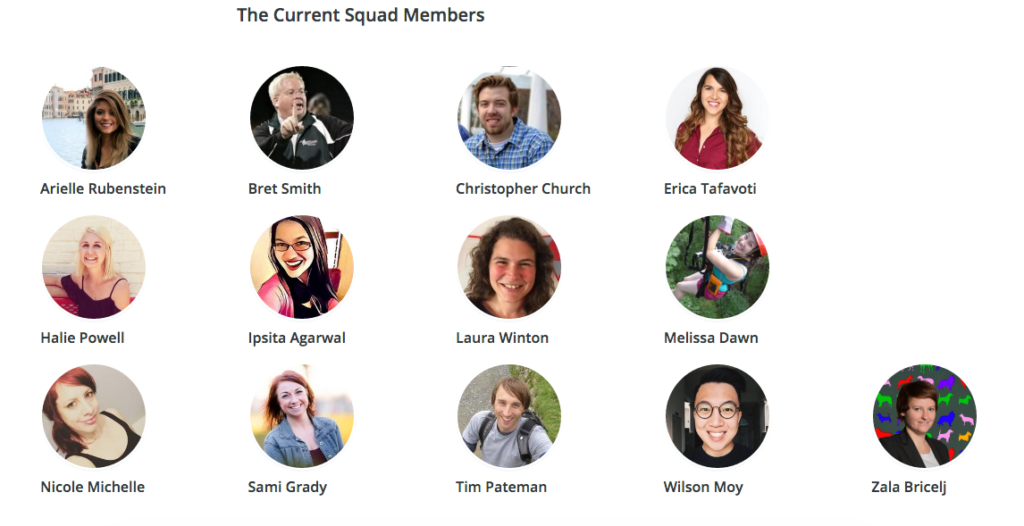
To cap it off, we’d love to share a few stellar tweets from our Squad:
From Laura Winton:
Thanks a ton for mentioning us on this great list, friends. We're touched. -Laura pic.twitter.com/g0vfro2uqU
— Buffer (@buffer) August 2, 2016
From Wilson Moy:
Thanks for sharing this article and for the shoutout, friends! ?? -Wilson pic.twitter.com/xXbKh06MDD
— Buffer (@buffer) July 31, 2016
From Melissa Dawn:
We really appreciate you, David! Thank you so much for sharing our story and being so supportive! Means the world! ? -Melissa
— Buffer (@buffer) June 25, 2016
There are so many more we could share, and we’re grateful for all future interactions from this amazing bunch of volunteers! Want to reach out to say “Hi!” to our Twitter Squad? Give us a shout at @buffer!
Over to you
Have you seen other examples of community-volunteer support? What do you think of our Twitter Squad program? How could we improve? We’d love to hear your thoughts on all this!
If you’re keen to keep an eye on when the Twitter Squad opens up again, we’ll post announcements at: buffer.com/twitter-squad and also tweet it out via @thedarcypeters @thomsonAUS and @juliabreathes
Try Buffer for free
190,000+ creators, small businesses, and marketers use Buffer to grow their audiences every month.



